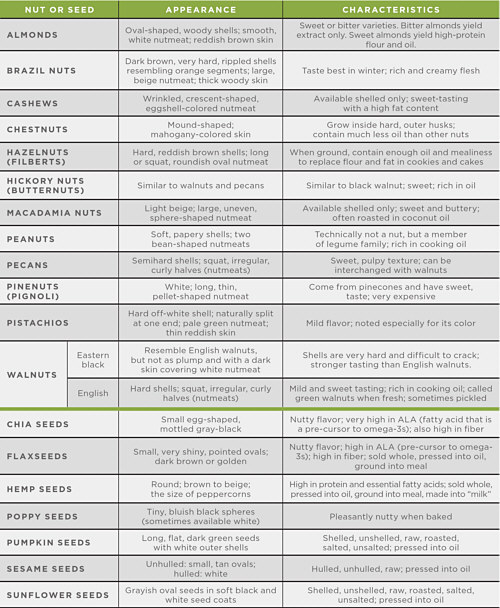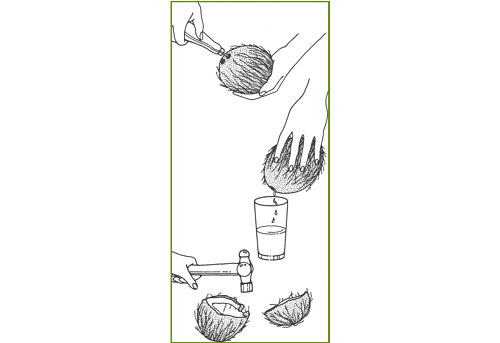Both seeds and nuts (which are also seeds in a sense) contain all the ingredients necessary to nourish and sustain a new plant. In fact, they hold even more nutrients, and in greater concentrations, than the plants they come from. The only caution when it comes to these nutritious foods is their high fat and calorie content. The fat in nuts and seeds is very healthful unsaturated fats to be sure, but they are extremely energy dense, and just a small handful packs in quite a few calories.
Buying Nuts
Nuts are in season in autumn and early winter, so that is the time to find the best-quality in-the-shell nuts. But you can usually buy several common types of nuts in supermarkets throughout the year. Specialty shops and natural foods stores are likely to have a good supply of the more unusual kinds. Buy nuts in stores that seem to sell a lot of them. That means quick turnover and less chance that the stock has become stale or rancid. Nuts tend to spoil quickly because of the oils they contain.
Whole nuts can be purchased either shelled or unshelled with the exception of cashews and macadamia nuts, which are only sold shelled. Roughly speaking, 1 pound of unshelled nuts will yield about ½ pound of shelled nuts. Shelled nuts are sold raw or roasted and blanched (skins removed) or natural (skins on).
Shelled nutmeats should be plump and fairly uniform in color and size, and they should look firm, not limp or rubbery. Dark or shriveled kernels suggest staleness and poor quality.
Buying Seeds
Sunflower seeds and pumpkin seeds can be purchased hulled or unhulled, raw or roasted, and unsalted or salted. Hulled pumpkin seeds are often sold under the name pepitas.
Sesame seeds come hulled and unhulled; the hulled seeds are a pearly white, and unhulled ones are a matte tan.
Poppy seeds can be bought in bulk in gourmet food shops and some ethnic markets, or in smaller jars in the spice aisle of supermarkets. White poppy seeds are available in Indian markets.
Chia seeds, known mostly in this country for the novelty of sprouting them on terra-cotta figurines, are actually very high in healthful fatty acids and soluble fiber.
Flaxseeds are available in whole seed form, both dark brown and golden, and also as a ground meal. The seeds are also pressed for oil, which is generally sold not for cooking but as a dietary supplement. The oil goes rancid very quickly and needs to be stored in the refrigerator.
Hemp seeds are available whole, as a ground meal, as flour, and as a milk (and yogurt). The seeds are pressed for oil, which is highly unsaturated and turns rancid quickly (like flaxseed oil). It must be kept refrigerated.
Storing Nuts & Seeds
The chemical changes that lead to rancidity in nuts begin almost as soon as the outside hull is removed. Pine nuts are especially susceptible to spoilage because they contain unstable resinous oils. Most shelled nuts will keep at least 4 months in the refrigerator, a good place to store them. (Nutmeats, packed airtight, also freeze well for up to a year.) Unshelled nuts will keep longer—about 1 year—in a cool, dry place and even longer under refrigeration.
Seeds, too, will go rancid if not refrigerated. This is especially true of flaxseeds and hemp seeds whose oils are particularly vulnerable to rancidity.
MAKING NUT OR SEED MEAL, MILK & BUTTER
Nut or seed meal makes exceptionally nutritious bread or porridge, or it can be used in sauces, piecrusts, cakes, and tortes. To make a nut or seed meal, grind the nuts or seeds, ¼ cup at a time, with either a small nut grinder or a mini food processor. Grinding in small batches produces a nut meal that is dry, not oily. To use the meal in breads, replace 2 or 3 tablespoons of wheat flour with nut meal for every 1 cup of flour. The texture of the bread will be changed only slightly.
Nuts and seed milk is as nutritious and good tasting as whole nuts. Nut milk, which incidentally is as perishable as cow’s milk, can be used as a quick energy drink or for sauces and soups. To make nut or seed milk, lightly roast and grind any nuts or seeds. While grinding, gradually add water (whole or reconstituted dry milk can also be used) until a desired consistency is reached. (When using sesame seeds, strain the blended mixture.) One-quarter cup of nuts or seeds will yield 1 cup of milk. Sweeten it with sugar, honey, or molasses, and add a few drops of vanilla extract if you like.
Nut or seed butter is made by grinding the nuts or seeds with a little bit of oil.
Place the 1 cup roasted peanuts, cashews, almonds, sunflower seeds, pumpkin seeds, or hemp seeds and 4 teaspoons vegetable oil in a food processor or large mini food processor. Pulse to combine, then process on high speed, scraping down the sides of the container as necessary. Blend until smooth. Store tightly covered in a cool place. Yields 1 cup
Preparing Nuts & Seeds
BLANCHING NUTS
The process that exposes the creamy white nutmeat by removing the thick skin that clings to the kernel is called blanching. Although this skin contains nutrients, some cooks remove it simply for the sake of appearance; others to better savor the nut’s own delicate flavor.
To blanch shelled almonds: Cover with boiling water and let stand for 1 to 2 minutes. Drain, rinse under cold water, and slide the skins off with your fingers. Spread the blanched nuts on paper towels to dry.
To blanch shelled chestnuts: Place in a pot of boiling water and let boil for 3 minutes. Remove a few at a time and let cool; then peel with a paring knife. If they don’t peel easily, boil for another minute or two.
To blanch hazelnuts by roasting: Spread shelled nuts in a single layer in a shallow baking pan. Bake at 300°F for 10 to 15 minutes, or until heated through, stirring occasionally to prevent burning. Place them in a kitchen towel and rub vigorously to get the skins off (they will not all come off ).
A GUIDE TO NUTS & SEEDS

MAKINGS ESAME SEED OR SUNFLOWER SEED YOGURT
Yogurt made from sesame or sunflower seeds is delicious as a salad dressing or as a dip for raw or cooked vegetables. To make the yogurt, soak ½ cup hulled, raw seeds for a full 24 hours. Drain the seeds and grind them in a mini food processor or blender; add ½ cup water and process the mixture at high speed for 20 seconds. Gradually add another ½ cup water and process for about 2 minutes. The consistency should be that of heavy cream. Pour the mixture into a yogurt maker, if you have one, or into a glass container (closed but not airtight), and let it stand for 8 to 24 hours at 70° to 80°F.
When it is ready, the yogurt will have a slightly tart flavor. Sunflower-seed yogurt will have a grayish color and the top sometimes turns very dark—unappetizing, but not harmful. Eat it or scrape it off. The yogurt will keep, refrigerated, for a week.

Piercing the “eyes” of a coconut
Draining out the coconut milk
CHOPPING NUTS
Chopped nuts make an attractive garnish as well as a delectable ingredient in many dishes. They can be chopped in a nut chopper, or you can chop them on a board or on a clean dish towel on a flat surface. Some cooks prefer a wooden bowl with a rounded chopper for this. You may also use a food processor, but you have to take care not to process the nuts into a paste.
OPENING A COCONUT
Technically a nut, but significantly different from other foods called nuts, the coconut is the fruit of a tropical palm. The nut contains thick, edible meat and a potable clear liquid called “milk.”
To open a coconut, pierce two of its three “eyes” with an ice pick or large nail, and drain the milk from the coconut. Refrigerate and enjoy as a refreshing drink. To remove the shell easily, bake the drained coconut at 350°F for 20 to 30 minutes, or put it in the freezer for 1 hour. Place the coconut on a firm surface and give the shell a quick, sharp blow with a hammer; it should break cleanly in two. Separate the meat from the shell with a sharp knife. The dark brown skin that clings tightly to the white meat can be peeled off with a vegetable peeler, if desired.
Store fresh coconut in the refrigerator. Whole, unshelled coconuts retain their quality for as long as a month in the refrigerator.
ROASTING OR TOASTING NUTS & SEEDS
Slight roasting or toasting of nuts and seeds heightens their rich flavor. You have to tend them carefully, however, because they can go very quickly from nicely browned to burned and bitter. There are three main methods:
Stove-top: In an ungreased heavy skillet, toast the nuts or seeds over medium heat, stirring regularly, for 10 to 15 minutes. Once they have taken on the color you want, scrape onto a heatproof plate to stop the cooking.
Oven: Spread the nuts or seeds in a shallow pan or on a baking sheet and slide into a 350°F oven. Roast, stirring occasionally, until fragrant and lightly browned, 5 to 10 minutes. Scrape onto a heatproof plate to stop the cooking.
Toaster oven: This is a good energy-saving method for seeds and small amounts of nuts. Roast at 350°F for 3 to 5 minutes. This goes more quickly than a conventional oven because it’s such an enclosed space.
ROASTING CHESTNUTS
Although technically classed as a tree nut, like almonds and walnuts, chestnuts do not have the same high fat content and need to be treated differently. To roast chestnuts, slash an X through the shells on the flat sides of the nuts. Place them, cut-side up, on baking sheets and roast at 400°F until tender, about 20 minutes. Insert a fork to test them for tenderness. When cool enough to handle, peel off the shells.
MAKING COCONUT MILK OR CREAM
The sweet liquid found inside a fresh coconut is called the “milk,” though it is anything but milky and is more technically called coconut water. The ingredient called coconut milk is made from the coconut oils pressed from the coconut flesh. It’s the core ingredient in Thai curries and adds richness to many Asian and Polynesian dishes. Coconut milk is available in cans and is sold in thin and thick (sometimes called coconut cream) forms; it is also sold in a lower-fat version. Neither of these should be confused with the canned sweetened cream of coconut used to make piña coladas. Here’s how to make your own coconut milk or cream:
To make coconut milk or cream: Either coarsely chop or grate fresh coconut meat. In a food processor, process no more than ½ cup coconut with ¼ cup of hot water at a time. Press the mixture in a strainer to extract the liquid. This first pressing, which is very rich, is generally referred to as coconut cream. If you continue to press the coconut, adding more water as you do, you will have a thinner liquid called coconut milk. To do this, return the puree to the food processor. For each ½ cup of puree, add another ½ cup of water, and blend again. Strain and measure.